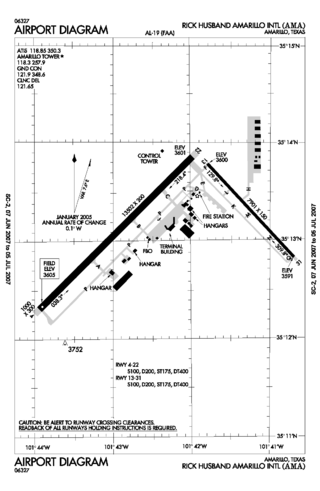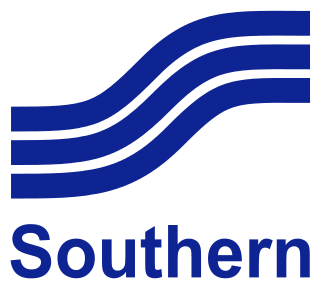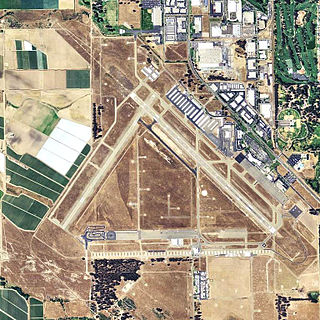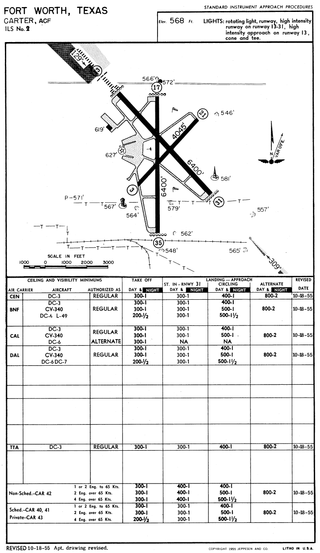
William P. Hobby Airport is an international airport in Houston, Texas, located 7 miles (11 km) from downtown Houston. Hobby is Houston's oldest commercial airport, and was its primary airport until the Houston Intercontinental Airport, now known as the George Bush Intercontinental Airport, opened in 1969. Hobby was initially closed after the opening of Houston Intercontinental; however, it was re-opened after several years, and became a secondary airport for domestic airline service, and a center for corporate and private aviation.

Destin–Fort Walton Beach Airport is an airport located within Eglin Air Force Base, adjacent to the city of Valparaiso and near the cities of Destin and Fort Walton Beach, in Okaloosa County, Florida, United States. The airport was previously named Northwest Florida Regional Airport until February 17, 2015, and Okaloosa Regional Airport until September 2008.
Panama City–Bay County International Airport(IATA: PFN, ICAO: KPFN, FAA LID: PFN) was a public airport 3 miles (4.8 km) northwest of Panama City, in Bay County, Florida. It was owned and operated by the Panama City–Bay County Airport and Industrial District. All airline services moved to the Northwest Florida Beaches International Airport on May 22, 2010, but the airfield was open to general aviation aircraft until October 1, 2010. The grounds will eventually be turned over to LUK-MB1 LLC, which plans to remove the runways and build homes, shops, walking trails and a marina.

Rick Husband Amarillo International Airport is a public airport six miles (10 km) east of downtown Amarillo, in Potter County, Texas, United States. The airport was renamed in 2003 after NASA astronaut and Amarillo native Rick Husband, who died in the Space Shuttle Columbia disaster in February of that year.

Corpus Christi International Airport is 6 miles west of Corpus Christi, in Nueces County, Texas. It opened in 1960, replacing Cliff Maus airport at 27.767°N 97.44°W, where the Lozano Golf Center is now located.
Jack Brooks Regional Airport, formerly Southeast Texas Regional Airport, is near Port Arthur, Texas, nine miles (14 km) southeast of Beaumont and northeast of Port Arthur. It was Jefferson County Airport, but its name was changed to honor former U.S. Representative Jack Brooks. The airport is southwest of the city of Nederland in unincorporated Jefferson County, and is used for general aviation. Southwest Airlines ended scheduled jet service in 1980 and several other airlines have started and ended service as well including American Eagle, Continental, Delta/Delta Connection and United Express. The latest chapter is the resumption of service by American Eagle for American Airlines to Dallas/Ft. Worth (DFW).

Southern Airways was a local service carrier, a scheduled airline certificated by the federal Civil Aeronautics Board, in the United States, from its founding by Frank Hulse in 1949 until 1979, when it merged with North Central Airlines to become Republic Airlines. Southern's corporate headquarters were in Birmingham, with operations headquartered at Hartsfield–Jackson Atlanta International Airport, near Atlanta.
Capitol Air was a United States supplemental air carrier and, after 1978, a scheduled passenger air carrier based which was operational from 1946 to its bankruptcy filing on November 23, 1984. It was founded as Capitol Airways in 1946, and then renamed Capitol International Airways in 1967. In 1981, the airline changed its name to Capitol Air and was operating scheduled domestic and international passenger flights that year.

Billings Logan International Airport is in the western United States, two miles northwest of downtown Billings, in Yellowstone County, Montana. It is the fourth largest airport in Montana, having been surpassed in recent years by Bozeman, Missoula, and Flathead County (Kalispell) in both number of gates as well as annual enplanements. Owned by the city of Billings, the airport is on top of the Rims, a 500-foot (150 m) cliff overlooking the downtown core, and covers 2,500 acres of land.

Tyler Pounds Regional Airport is a city-owned, public-use airport located 3 mi (4.8 km) west of Tyler, in Smith County, Texas, United States.

Santa Maria Public Airport is three miles (5 km) south of Santa Maria, in northern Santa Barbara County, California, United States.

Fort Smith Regional Airport is a public use airport located near the Interstate 540 freeway three nautical miles (6 km) southeast of the central business district of Fort Smith, in Sebastian County, Arkansas, United States. FSM is governed by the Fort Smith Airport Commission as established by the City of Fort Smith, Arkansas. It serves the transportation needs of residents and businesses of western Arkansas and eastern Oklahoma. FSM is currently served by American Eagle, the regional airline affiliate of American Airlines. It has a large population of corporate and general aviation aircraft. A full-service fixed-base operator (FBO), Signature Flight Support, provides service to general aviation, airline, and military operators.
Memorial Field Airport is located in City of Hot Springs, in Garland County, Arkansas, United States, 3 miles (4.8 km) southwest of Downtown Hot Springs. It serves nearby Hot Springs National Park. The airport is used for general aviation; airline flights are subsidized by the federal government's Essential Air Service program at a cost of $1,637,012.

Juneau International Airport is a city-owned, public-use airport and seaplane base located seven nautical miles northwest of the central business district of Juneau, a city and borough in the U.S. state of Alaska that has no direct road access to the outside world. The airport serves as a regional hub for all air travel, from bush carriers to major U.S. air carriers such as Alaska Airlines.

Brownsville/South Padre Island International Airport is 5 miles east of downtown Brownsville, Cameron County, Texas.

Greater Southwest International Airport, originally Amon Carter Field (ACF), was the commercial airport serving Fort Worth, Texas, from 1953 until 1974. Dallas/Fort Worth International Airport opened in 1974 a few miles north to replace Greater Southwest and Dallas Love Field as a single airport for the Dallas-Fort Worth Metroplex. The area is now a commercial/light-industrial park serving DFW International, centered along Amon Carter Boulevard, which follows the old north-south runway.

Annette Island Airport is located on Annette Island in the Prince of Wales – Hyder Census Area of the U.S. state of Alaska. It is located 5 nautical miles (9 km) south of Metlakatla, Alaska. The airport was established as the Annette Island Army Airfield during World War II and initially served as a military airbase.
National Airlines was a trunk carrier, a scheduled airline in the United States that operated from 1934 to 1980, when it merged with Pan Am. For most of its existence the company was headquartered at Miami International Airport, Florida. At its height, National Airlines had a network of "Coast-to-Coast-to-Coast" flights, linking Florida and Gulf Coast destinations such as New Orleans and Houston with cities along the East Coast as far north as Boston as well as with large cities on the West Coast including Los Angeles, San Francisco and Seattle. From 1970 to 1978, National, Braniff International Airways, Pan American World Airways and Trans World Airlines (TWA) were the only U.S. airlines permitted to operate scheduled passenger flights to Europe.

Robert Mueller Municipal Airport(IATA: AUS, ICAO: KAUS, FAA LID: AUS) was the first civilian airport built in Austin, Texas, United States. It was located a few miles northeast of downtown Austin. It was replaced as Greater Austin's main airport by the Austin–Bergstrom International Airport, which is located on the site of the former Bergstrom Air Force Base. The airport was named after Robert Mueller, a city commissioner who died in office in January 1927. Robert Mueller Municipal Airport was identified with the airport code AUS, which was reassigned to Austin–Bergstrom International Airport in 1999.
Aerovias Guest S.A. was Mexico's third airline founded after Mexicana de Aviación and Aeronaves de Mexico. It was later taken over by Aeronaves de Mexico when it declared bankruptcy.

















